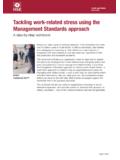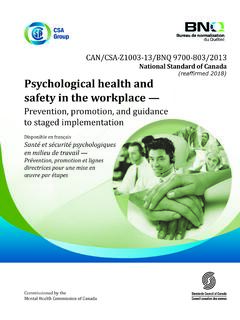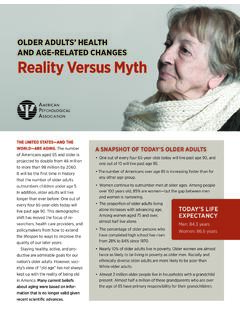Transcription of Work-related stress, anxiety or depression statistics in ...
1 This document is available from Page 1 of 10 health and Safety Executive work related stress depression or anxiety statistics in Great Britain, 2018 Contents 2 4 3. Work-related stress, depression or anxiety by industry group 5 related stress, depression or anxiety by occupational category 6 stress, depression or anxiety by age and gender 7 stress, depression or anxiety and workplace size 7 of workplace stress 8 9 Annual statistics Published 31st October 2018 This document is available from Page 2 of 10 The document can be found at: Stress, depression or anxiety in Great Britain 595,000 Workers suffering from Work-related stress, depression or anxiety (new or long-standing) in 2017/18 Labour Force Survey (LFS) million Working days lost due to Work-related stress, depression or anxiety in 2017/18 Labour Force Survey (LFS) Stress, depression or anxiety by cause, averaged 2009/10-2011/12 Source.
2 Labour Force Survey Industries with higher than average rates of stress, depression or anxiety , averaged 2015/16- 2017/18 Source: Labour Force Survey This document is available from Page 3 of 10 Stress, depression or anxiety per 100,000 workers: new and long-standing Source: Labour Force Survey Work-related stress, depression or anxiety is defined as a harmful reaction people have to undue pressures and demands placed on them at work . The latest estimates from the Labour Force Survey (LFS) show: The total number of cases of work related stress, depression or anxiety in 2017/18 was 595,000, a prevalence rate of 1,800 per 100,000 workers. This was not statistically significantly different from the previous period. The rate of work related stress depression and anxiety was broadly flat but has shown signs of increasing in recent years. The number of new cases was 239,000, an incidence rate of 720 per 100,000 workers.
3 The total number of working days lost due to this condition in 2017/18 was million days. This equated to an average of days lost per case. Working days lost per worker due to self-reported Work-related stress, depression or anxiety shows no clear long term trend. In 2017/18 stress, depression or anxiety accounted for 44% of all Work-related ill health cases and 57% of all working days lost due to ill health . Stress, depression or anxiety is more prevalent in public service industries, such as education; health and social care; and public administration and defence. By occupation, professional occupations that are common across public service industries (such as healthcare workers; teaching professionals and public service professionals) show higher levels of stress as compared to all jobs. The main work factors cited by respondents as causing work related stress, depression or anxiety were workload pressures, including tight deadlines and too much responsibility and a lack of managerial support (2009/10-2011/12).
4 This document is available from Page 4 of 10 Figure 1. Estimated prevalence rates of self-reported stress, depression or anxiety caused or made worse by work in Great Britain, for people working in the last 12 months Work-related stress is defined as a harmful reaction that people have to undue pressures and demands placed on them at work . By its very nature, stress is difficult to measure and HSE has two different data sources from which to conduct analysis. The preferred data source used by HSE for calculating rates and estimates for stress, depression or anxiety is the Labour Force Survey (LFS). The LFS is a household survey consisting of around 38,000 households per quarter across Great Britain which provides information about the labour market. HSE commissions a module of questions in the LFS to gain a view of Work-related illness based on individuals perceptions. The LFS provides national estimates and corresponding rates of the overall prevalence (total cases) of self-reported Work-related illness during the previous 12 months, which includes long standing and new cases.
5 It also provides estimates of new cases of Work-related illness in the same period and of annual working days lost due to Work-related illness. Estimates and rates relate to people working in the previous 12 months. statistics presented in this document are based on the LFS data, unless otherwise specified. In addition to the LFS, HSE also collects data on Work-related stress through The health and Occupation Research network for general practitioners (THOR-GP) across Great Britain. This network asks reporting general practitioners to assess whether new cases of mental ill health presented in their surgeries are Work-related , and if so, what was the Work-related cause of this disorder. The two data sources may reflect different perceptions of work related attribution to individual cases. Longitudinal studies and systematic reviews have indicated that stress at work is driven largely by psychosocial factors and is associated with common conditions such as heart disease and anxiety and depression and may play a role in some forms of musculoskeletal disorders This document is available from Page 5 of 10 Figure 2.
6 Days lost due to self-reported Work-related stress, depression or anxiety , for people working in the last 12 months 3. Work-related stress, depression or anxiety by industry group The average prevalence rate for Work-related stress, depression or anxiety across all industries was 1,320 cases per 100,000 workers over the three-year period 2015/16 2017/18. The broad industry category of Public administration and defence; compulsory social security has a rate of 1,960 cases per 100,000 workers; Human health and social work activities 2080 cases per 100,000 workers and Education, 2100 cases per 100,000 workers each with a statistically significantly higher rate than the average for all industries. Figure 3. Prevalence rate for Work-related stress, depression or anxiety in Great Britain, by broad industry category, per 100,000 people employed in the last 12 months, averaged over the period 2015/16/-2017/18 This document is available from Page 6 of 10 related stress, depression or anxiety by occupational category Those occupational groups with the high prevalence rates of Work-related stress, depression or anxiety broadly reflect the types of occupations found in the industries mentioned above.
7 Figure 4. Prevalence rate of Work-related stress, depression or anxiety in Great Britain, by broad occupational category, per 100,000 people employed in the last twelve months, averaged over the period 2015/16-2017/18 The Professional occupations category has statistically significantly higher rate of Work-related stress, depression or anxiety than the rate for all occupations. For the three-year period averaged over 2015/16-2017/18, the Professional occupations category had 2,090 cases per 100,000 people employed, compared with 1,320 cases for all occupational groups. However the broad categories of Skilled trades, Elementary occupations and Process plant and machine operatives had statistically significantly lower rates of Work-related stress, depression or anxiety at 600, 780 and 630 cases per 100,000 workers respectively. Looking more closely at the broad category of Professional occupations we can assess which professions are driving the higher rates of Work-related stress, depression or anxiety .
8 Nursing and midwifery professionals at 2,760 cases per 100,000 workers, Teaching professions at 3,020 cases, Welfare professionals at 4,080 cases. Other professions with higher rates include Legal professionals, protective services and those in customer services. Figure 5. Prevalence rate of self-reported Work-related stress, depression or anxiety in Great Britain, within the category of Professional occupations per 100,000 people employed averaged over the period 2015/16-2017/18 This document is available from Page 7 of 10 stress, depression or anxiety by age and gender In the three year period 2015/16-2017/18 the average prevalence rate for Work-related stress, depression or anxiety for males was 1,370 cases and 1,950 cases for females per 100,000 workers. Females had a statistically significantly higher rate than males in this period. The rate for all persons was 1,640 per 100,000 workers. For males, the 16-24 years (760 cases per 100,000 male workers) 25-34 years and 55+ (1,090 cases per 100,000 male workers) had statistically significantly lower rates than all persons combined in this period.
9 Males in the 35-44 and 45-54 years were not significantly different from the all persons rate. Within the female age categories 16-24 years at the rate of 1,250 cases per 100,000 workers were statistically significantly lower than the rate for all persons. Females in the categories 25-34, 35-44 and 45-54 had significantly higher rates than all persons being 2,080, 2,490 and 2,120 cases per 100,000 workers (see Figure 6). Those in the 55+ category were not significantly different from the all persons rate. Figure 6. Prevalence rate of self-reported Work-related stress, depression or anxiety in Great Britain, by age and gender per 100,000 workers averaged over the period 2015/16-2017/18 stress, depression or anxiety and workplace size Compared with the rate across all workplaces sizes, small workplaces had a statistically significantly lower rate of Work-related stress, depression or anxiety whilst large workplaces had statistically significantly higher rates.
10 Medium enterprises were not significantly different from the rate across all workplaces. The rate across all workplace sizes was 1,320 cases per 100,000 workers with Small (fewer than 50 employees) 1,030 cases, Medium (50-249 employees) 1,500 cases and Large (250+ employees) 1,940 cases. This document is available from Page 8 of 10 Figure 7. Prevalence rates of self-reported Work-related stress, depression or anxiety in Great Britain, by workplace size per 100,000 workers, averaged over the period 2015/16-2017/18 of workplace stress The predominant cause of Work-related stress, depression or anxiety from the Labour Force Survey (2009/10-2011/12) was workload, in particular tight deadlines, too much work or too much pressure or responsibility. Other factors identified included a lack of managerial support, organisational changes at work , violence and role uncertainty (lack of clarity about job/uncertain what meant to do.)
















